
A psychiatric hospital, also known as a mental health hospital, a behavioral health hospital, or an asylum is a specialized medical facility that focuses on the treatment of severe mental disorders. These institutions cater to patients with conditions such as schizophrenia, bipolar disorder, major depressive disorder, and eating disorders, among others.

The Belchertown State School for the Feeble-Minded was established in 1922 in Belchertown, Massachusetts. It became known for inhumane conditions and poor treatment of its patients, and became the target of a series of lawsuits prior to its eventual closing in 1992. The building complex was listed on the National Register of Historic Places in 1994.
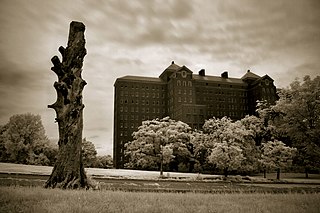
The Kings Park Psychiatric Center, known by Kings Park locals as "The Psych Center", is a former state-run psychiatric hospital located in Kings Park, New York. It operated from 1885 until 1996, when the State of New York closed the facility, releasing its few remaining patients or transferring them to the still-operational Pilgrim Psychiatric Center.
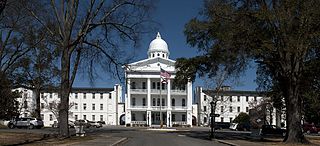
Bryce Hospital opened in 1861 in Tuscaloosa, Alabama, United States. It is Alabama's oldest and largest inpatient psychiatric facility. First known as the Alabama State Hospital for the Insane and later as the Alabama Insane Hospital, the building is considered an architectural model. The hospital houses 268 beds for acute care, treatment and rehabilitation of full-time (committed) patients. The Mary Starke Harper Geriatric Psychiatry Hospital, a separate facility on the same campus, provides an additional 100 beds for inpatient geriatric care. The main facility was added to the National Register of Historic Places in 1977.
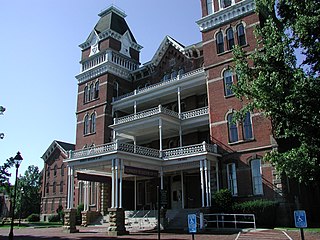
The Athens Lunatic Asylum, now a mixed-use development known as The Ridges, was a Kirkbride Plan mental hospital operated in Athens, Ohio, from 1874 until 1993. During its operation, the hospital provided services to a variety of patients including Civil War veterans, children, and those declared mentally unwell. After a period of disuse the property was redeveloped by the state of Ohio. Today, The Ridges are a part of Ohio University and house the Kennedy Museum of Art as well as an auditorium and many offices, classrooms, and storage facilities.
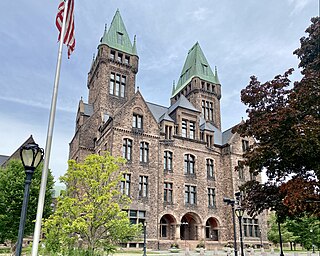
The Richardson Olmsted Campus in Buffalo, New York, United States, was designated a National Historic Landmark in 1986. The site was designed by the American architect Henry Hobson Richardson in concert with the famed landscape team of Frederick Law Olmsted and Calvert Vaux in the late 1800s, incorporating a system of treatment for people with mental illness developed by Dr. Thomas Story Kirkbride known as the Kirkbride Plan. Over the years, as mental health treatment changed and resources were diverted, the buildings and grounds began a slow deterioration. By 1974, the last patients were removed from the historic wards. On June 24, 1986, the former Buffalo State Asylum for the Insane was added to the National Historic Landmark registry. In 2006, the Richardson Center Corporation was formed to restore the buildings.
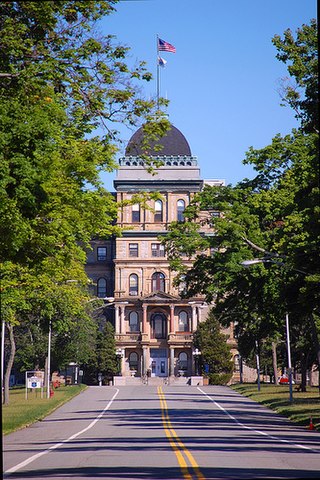
Greystone Park Psychiatric Hospital referred to both the former psychiatric hospital and the historic building that it occupied in Morris Plains, New Jersey. Built in 1876, the facility was built to alleviate overcrowding at the state's only other "lunatic asylum" located in Trenton, New Jersey.
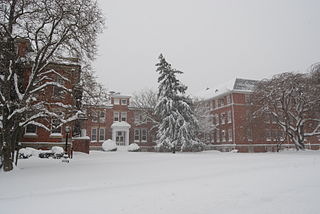
The Crownsville Hospital Center was a psychiatric hospital located in Crownsville, Maryland. It was in operation from 1911 until 2004.

Oregon State Hospital is a public psychiatric hospital in the U.S. state of Oregon, located in the state's capital city of Salem with a smaller satellite campus in Junction City opened in 2014. Founded in 1862 and constructed in the Kirkbride Plan design in 1883, it is the oldest operating psychiatric hospital in the state of Oregon, and one of the oldest continuously operated hospitals on the West Coast.

The Institute of Pennsylvania Hospital, also known as Kirkbride's Hospital or the Pennsylvania Hospital for Mental and Nervous Diseases, was a psychiatric hospital located at 48th and Haverford Streets in Philadelphia, Pennsylvania, USA. It operated from its founding in 1841 until 1997. The remaining building, now called the Kirkbride Center is now part of the Blackwell Human Services Campus.

Dixmont State Hospital was a hospital located northwest of Pittsburgh, Pennsylvania. Built in 1862, Dixmont was once a state-of-the-art institution known for its highly self-sufficient and park-like campus, but a decline in funding for state hospitals and changing philosophies in psychiatric care caused the hospital to be closed in 1984. After more than two decades of abandonment, it was demolished in 2006. The campus spanned a total of 407 acres (165 ha). Reed Hall is listed on the National Register of Historic Places.

Parkwood is a neighborhood located in the Far Northeast section of Philadelphia, Pennsylvania, United States. The neighborhood's boundaries include the Byberry East Industrial Park to the north and northwest, Poquessing Creek to the east, Knights Road to the southeast and Woodhaven Road to the southwest. The neighborhood was developed by Hyman Korman in the 1960-1962 as a planned residential community. The predominant housing type is the brick row house. The Parkwood Shopping Center is a local shopping destination, while the Philadelphia Mills mall is a regional shopping destination on Knights Road to the east of Parkwood's residential area.

The Rosewood Center was an institution for people with developmental disabilities located on Rosewood Lane in Owings Mills, Maryland.

Norristown State Hospital, originally known as the State Lunatic Hospital at Norristown, is an active state-funded psychiatric hospital located outside the city of Philadelphia in suburban Norristown, Pennsylvania. It was originally designed between 1878 and 1880, by the local firm of Wilson Brothers & Company; of which, the original structure was set in a red brick Victorian High Gothic motif. It remains active for its originally clinical intention, and currently serving Bucks County, Chester County, Delaware County, Montgomery County and Philadelphia County, providing clinical services in General Psychiatry and Forensic Psychiatry. Additionally, there are various agencies that sublet state hospital buildings for a variety of psychiatric, residential and social services. These agencies currently make up the majority of services that are offered on the grounds of the hospital.

Henryton State Hospital is a now-demolished hospital complex in Marriottsville, in southern Carroll County, Maryland, just across the Howard County line. The complex was located within Patapsco Valley State Park and along its southern end runs CSX's Old Main Line Subdivision and is very close to the Henryton Tunnel. The Henryton State Hospital center, or the Henryton Tuberculosis Sanatorium as it was called, was erected in 1922 by the Maryland Board of Mental Hygiene. It was established as a facility to treat African Americans suffering from tuberculosis. This was one of the first such facilities in Maryland erected to provide African Americans with the same level of treatment as white people. Other accounts state that this was more of containment Hospital rather than a treatment facility. They contend that Henryton was used more for the exile and quarantine of tuberculosis patients.

The North Princeton Developmental Center, formerly known as the New Jersey State Village for Epileptics, was a medical facility within Montgomery Township, Somerset County, New Jersey. The facility was home to a variety of mental health institutions throughout the years. In 2011, the former self-sustaining mental health village was slated for demolition to make space for a proposed county park. Demolition was completed in 2012 with plans to begin construction of the conceptual park in 2013. The facility garnered much notoriety over the past decades due to its "ghost town" appearance and mention in the popular book and periodical, "Weird N.J." Until its demolition, the former hospital was a popular place for "urban explorers" to explore, despite the buildings being unsafe (partially due to asbestos and lead paint contamination. Urban explorers were often met with resistance from law enforcement, as the site was prone to criminal activity, ranging from graffiti to arson. Prior to the demolition of the site, state and local governments have both made reasonable attempts to keep trespassers out, for example by sealing the entrances and windows of the property, though these methods proved to be relatively ineffective.
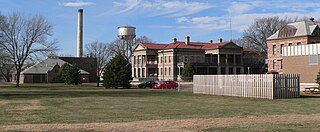
The Human Services Center in Yankton, South Dakota is a psychiatric hospital that was built in 1882. It was listed on the National Register of Historic Places in 1980.

Danville State Hospital in Danville, Pennsylvania is a mental health facility operated by the Pennsylvania Department of Public Welfare. It was Pennsylvania's third public facility to house the mentally ill and disabled.

The Philadelphia Naval Hospital was the first high-rise hospital building constructed by the United States Navy. At its 1935 opening it represented a state-of-the-art facility for the Navy with 650 beds and a total floor space of 352,000 square feet (32,700 m2). The dedicated medical purpose of this facility contributed to the World War II mission as the center for amputation, orthopedic and prosthetic services for Navy, Marine, and Coast Guard veterans residing east of the Rocky Mountains.

Kingsley Green is a mental health and learning disability site located in Hertfordshire, England, just southeast of the village of London Colney.





















